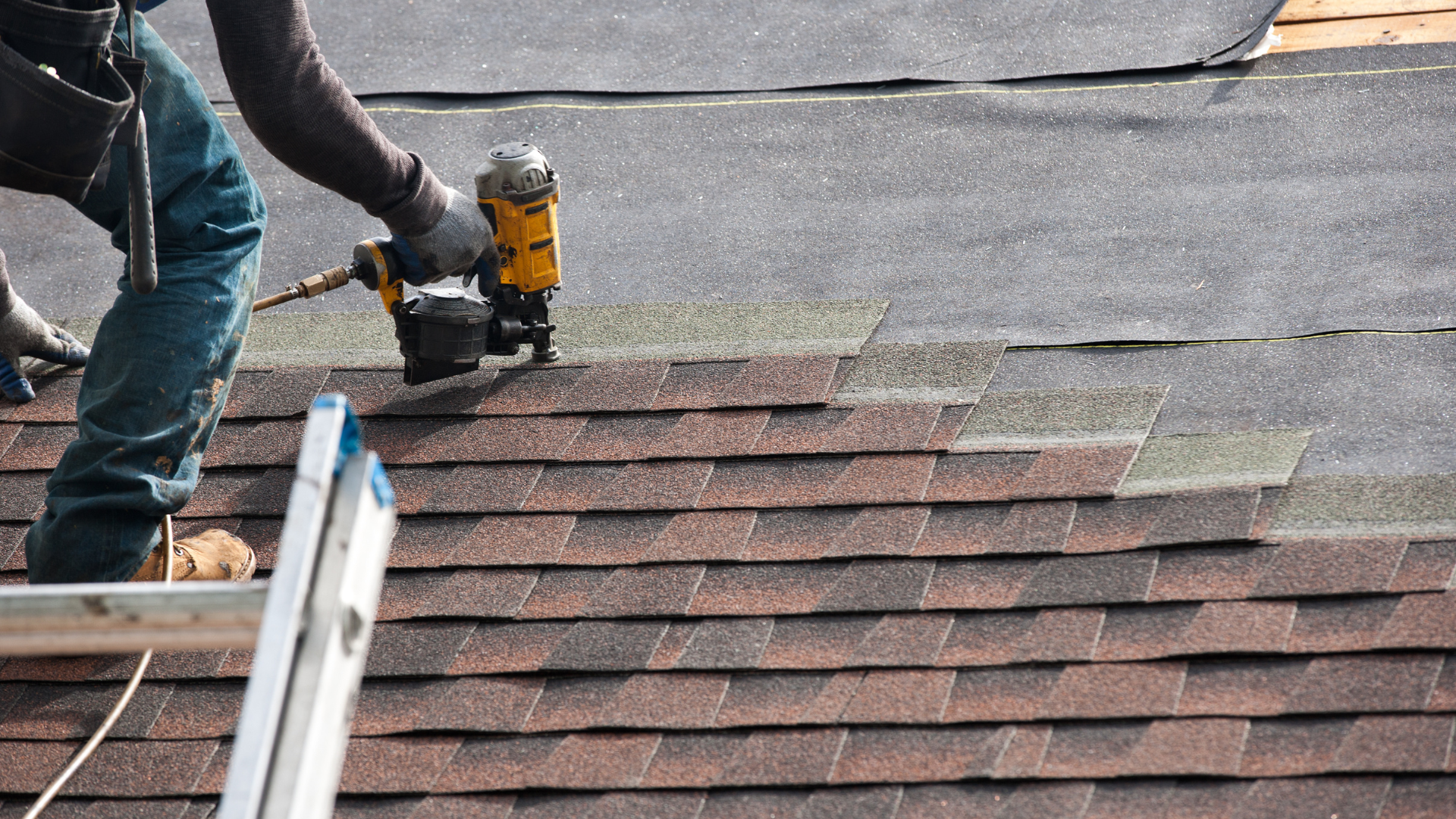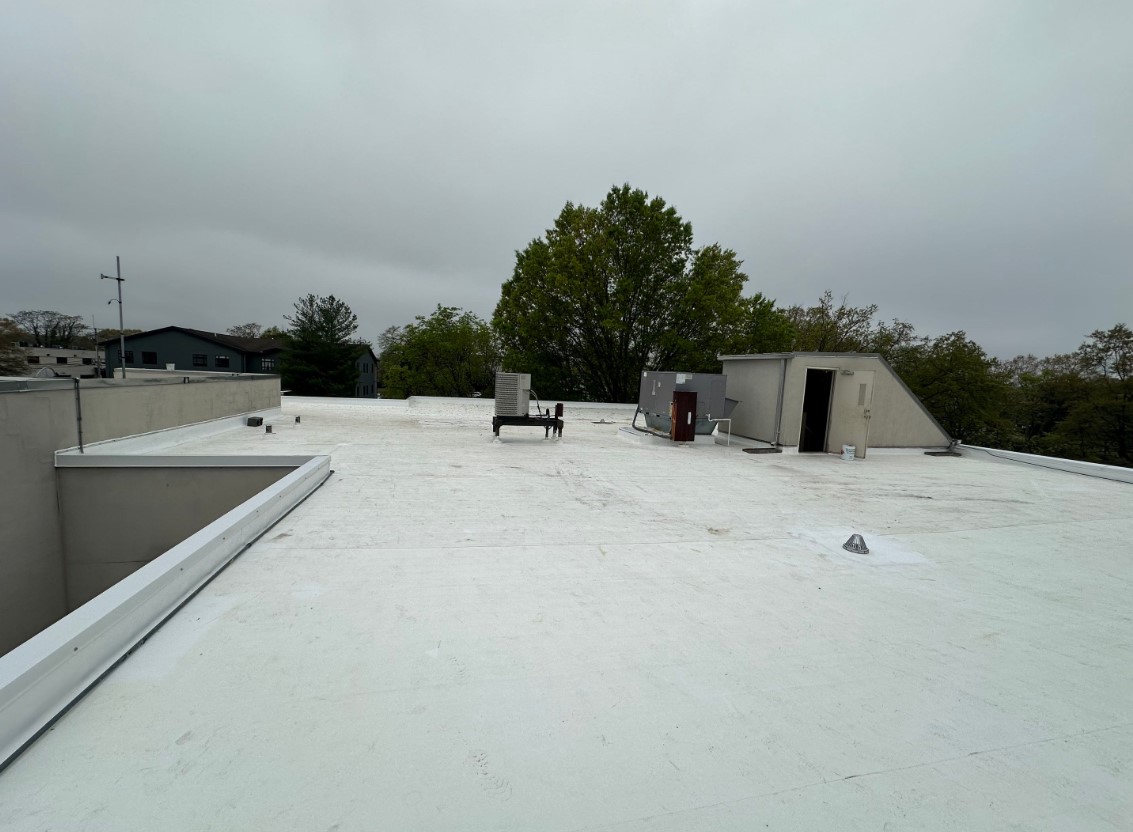Facing roof damage can be daunting, but filing an insurance claim doesn’t have to be. With the right knowledge and preparation, you can navigate the process confidently, ensuring your roof is restored promptly and efficiently.
It’s vital to be aware of this process as some homeowners insurance might cover the cost of replacing your entire roof even if only part of it is damaged.
We will explain what kinds of roof damage are usually covered and share tips on dealing with insurance companies.
Understanding Roof Damage Insurance Coverage
Roof damage insurance coverage is a key part of homeowners insurance. It covers various types of roof damage but also has some exclusions.
Types of Roof Damage Covered by Homeowners Insurance
Homeowners insurance can cover various roof damages. These include issues from weather events to unexpected accidents. They typically cover damage caused by:
- Falling objects like trees or hail
- Fire
- Hailstorms
- Lightning strikes
- Smoke damage from fires
- The weight of ice and snow
- Strong winds
- Vandalism
The average payout for wind and hail claims is around $13,000. For severe cases like fire and lightning, it’s much higher – about $83,519 between 2017-2022.
Common Exclusions in Roof Damage Coverage
Being aware of what your policy doesn’t cover is as important as knowing what it does. Common exclusions include:
- Neglect of maintenance: Damage due to lack of regular maintenance isn’t covered in your policy.
- Earthquakes: Damages caused by earthquakes need distinct coverage.
- Floods: Similarly, damage via floods is not included in standard policies.
- Normal deterioration: Older roofs can’t make claims merely for being aged.
- Cosmetic damage: If it’s only about aesthetics and not function, your policy might not cover it.
Without an endorsement for a “fortified roof,” there’s no way to improve your policy to cover extra risks.
Some prefer to leave out wind and hail coverage to reduce their expenses, but this causes a void in protection.
Fraudulent practices exist as well. Stay clear from those asking for excessive advance payments or offering deals that appear suspect.
The Claims Process for Roof Damage
Filing a claim for roof damage starts with understanding the steps involved. You need to know what your insurance adjuster will look for during their visit.
Steps to Filing a Claim
Filing a claim for roof damage to your insurance involves understanding what to do. Keep the following steps in mind to simplify the process.
- Review Your Insurance Policy: Start by carefully reviewing your insurance policy. Understand what types of damage are covered and note any exclusions.
- Notify Your Insurance Company: As soon as you spot roof damage, contact your insurance company. Provide them with detailed information about the damage and any supporting documents.
- Document the Damage: Take clear photos and videos of the damage from different angles. Include close-up shots and wider views to capture the full extent of the damage.
- List Affected Items and Costs: Make a list of all damaged items and any repair costs you already know. This helps provide a clear picture of the financial impact.
- Prepare for the Roof Inspection: An insurance adjuster will visit to assess the damage. They’ll look for missing or damaged shingles, water damage, signs of wear and tear, and the overall condition of your roof.
- Provide Detailed Information: During the adjuster’s visit, make sure to share all the details and documents you’ve gathered. Their findings will heavily influence the outcome of your claim.
- Remember Your Deductible: Be aware that your deductible will be subtracted from the payment you receive, so factor this into your expectations.
- Know What to Expect During the Adjuster’s Visit: Understanding what the adjuster is looking for can help you be better prepared and ensure a smoother process.
By following these steps, you can simplify the claims process and improve your chances of a successful outcome.
What to Expect from an Insurance Adjuster
An insurance adjuster checks your roof for different damages. They look for missing or damaged shingles, water damage under those shingles, wear and tear signs, and the overall state of harm.
They also notice what type of roof you have. This check helps them decide if your claim is valid and how much money you should get. Ensure that during the adjuster’s visit, you provide all necessary documentation and be available to answer any questions they may have.
The amount you receive depends on your policy details like coverage limits and deductibles. The adjuster plays a key role in approving your claim based on their findings.
Key Considerations When Filing a Claim

Before you file a roof damage claim, there are a few key steps you should take to ensure a smooth process and the best possible outcome.
Review Your Insurance Policy
First, take a close look at your insurance policy. It’s crucial to understand the specific details of your coverage, especially when it comes to how your payout will be calculated. Your policy will generally fall into one of two categories:
- Actual Cash Value (ACV): This type of policy pays out based on the current, depreciated value of your roof. For example, if your roof is 10 years old and has a life expectancy of 20 years, the insurance company will subtract the 10 years of depreciation from the payout. This means you’ll receive less money, reflecting the roof’s reduced value due to age and wear.
- Replacement Cost Value (RCV): An RCV policy covers the full cost to replace your roof with a new one of similar kind and quality, without factoring in depreciation. For instance, if your roof is damaged and needs to be replaced, the insurance company will pay for a new roof, minus your deductible, regardless of the roof’s age.
Understanding whether your policy is ACV or RCV can significantly affect how much money you receive after a claim.
Get a Professional Roof Inspection
After reviewing your policy, the next step is to have a professional roofer inspect and document the damage. A thorough inspection and detailed documentation, including photos and a written estimate, are crucial for filing a strong claim.
Consider Your Deductible
Remember that your deductible—the amount you’re responsible for before insurance kicks in—will be subtracted from your payout. Also, if you have a wood roof, you may be paying higher premiums due to the increased risk, which is something to keep in mind when assessing your coverage and potential claim.
By understanding these key considerations, you can better prepare for the claims process and ensure you’re fully covered for any roof damage.
Professional Inspections and Documenting the Damage
After reviewing your insurance policy details, the next important step is to get a professional roofer to inspect and document the damage. This process is crucial for your claim.
- Find a licensed roofer with good reviews.
- Schedule an inspection as soon as you notice roof damage.
- The roofer will check the entire roof carefully.
- They will take photos of all the damaged areas.
- Get a repair estimate on company letterhead from the roofer.
- This estimate should list all needed repairs and their costs.
- Make sure the roofer notes any immediate fixes to prevent more damage.
- Do not start major repairs until your insurance approves the claim.
- Keep copies of all documents and photos for your records.
Following these steps helps prove your claim and speeds up the repair process.
Importance of Timely Filing
Filing your claim right away is key. If you wait too long, it can hurt your chances of getting paid by the insurance. Some policies have strict deadlines for when to report damage.
If you miss these, you might not get help at all.
Acting quickly also helps stop more damage. For example, a small leak can turn into a big problem if not fixed fast. Your insurance company will see this fast action as good care of your home.
This makes them more likely to cover the costs.
Dealing with Claim Denials or Underpayments
Facing a denied or underpaid roof damage claim can be frustrating. Learn how to challenge these decisions and improve your chances for a fair settlement by reading on.
How to Appeal a Denied Claim
Receiving a denial on your roof damage claim can be frustrating, but don’t lose hope. Here’s how to appeal effectively:
- Review the Rejection Letter: Carefully read the letter to understand why your claim was denied.
- Gather Additional Evidence: Take new, clear photos of the damage to strengthen your case.
- Get a Roofing Expert’s Report: Have a certified roofer inspect the damage and provide a detailed report.
- Recheck Your Policy: Review your policy to find coverages that support your claim.
- Write an Appeal Letter: Clearly state your case, attach all new evidence, and request a reassessment.
- Consider a Public Adjuster: If needed, hire a public adjuster to help advocate for your claim.
- Contact State Insurance Department: If necessary, seek guidance or file a complaint with your state’s insurance department.
- Document Everything: Keep records of all communications with your insurance company.
- Be Patient and Persistent: Follow up regularly and stay committed to the process.
By following these steps, you can build a strong case to appeal your denied claim and increase your chances of a successful outcome.
Tips for Negotiating with Insurers
Negotiating with insurers can be tough. Knowing the right approach can make a big difference.
- Review your policy carefully: Understand what your insurance covers and note any exclusions. This knowledge is your base for negotiation.
- Get a professional inspection: Hire a roofer to document the damage in detail. Insurers respect professional opinions.
- Collect multiple quotes: Obtain repair estimates from several roofers. This shows the insurer reasonable costs.
- Document everything: Keep records of all communications, quotes, and reports. Written evidence supports your claim.
- Highlight policy details: Point out specific coverage clauses that support your claim during discussions.
- Be patient but persistent: Insurance processes take time, but regularly follow up to keep things moving.
- Seek a second opinion if denied: Hiring another adjuster or a structural engineer can provide new evidence for appeals.
- Consult an attorney for appeals: Sometimes legal advice is necessary to contest denials or underpayments effectively.
- Prepare to compromise: Be ready to negotiate on some aspects of the claim, like repair methods or cost adjustments.
Knowing these tips can lead to successful negotiations with your insurer over roof damage claims.
Preventative Measures and Roof Maintenance

Regular roof inspections and proper maintenance can prevent future damage. Choosing sturdy materials for your roof also helps avoid costly repairs.
Regular Inspections and Maintenance Tips
Maintaining your roof in prime condition is essential to steer clear of hefty repairs. Consistent upkeep can assist in early detection of issues. Here are the steps:
- Set a routine to have an inspection by a professional roofer every few years. They can identify problems that you may overlook.
- Inspect for loose or absent shingles frequently, particularly after major storms.
- Purge your gutters biannually to avert water damage and leaks.
- Prune tree branches that are overhanging your roof to prevent damage from falling limbs.
Farmers Mutual Insurance Co. of Nebraska points out that wooden roofs require extra maintenance, which can increase insurance premiums by approximately 25%. This highlights the role of regular checks for these types of materials.
Following up, we will discuss the importance of punctual filing for insurance claims.
Choosing Durable Materials to Mitigate Future Damage
After learning about regular roof inspections and upkeep, picking strong materials is the next step. Durable roofing elements can withstand more damage from storms or wear over time.
For example, fortified roofs meet standards set by the Institute for Business & Home Safety. This means they are built to resist severe weather better than other types.
Some people opt for asphalt shingles because they get a full replacement if hail damages them. Others may choose to not cover wind and hail in their insurance to save money. Investing in these stronger materials might cost more at first but can save you money on repairs or replacements later on.
Take Action
Navigating a roof damage insurance claim doesn’t have to be overwhelming. By understanding your policy, documenting the damage thoroughly, and following the proper steps, you can confidently manage the process. Regular roof inspections and maintenance are key to preventing future issues and ensuring a smoother claims experience.
If you’re facing roof damage and need expert guidance, contact Landmark Roofing today. Our team is here to help you every step of the way, from inspections to repairs, ensuring your home is protected and your claim is handled with care.
FAQs
1. What is the first step in filing a roof damage insurance claim?
The first step is to assess the extent of the roof damage. It’s important to contact a professional roofer for a thorough inspection before reaching out to your insurance company.
2. How can I navigate my roof damage insurance claim confidently?
Understanding your policy coverage and maintaining clear communication with your insurance company are key factors for navigating your claim confidently.
3. What role does an accurate damage assessment play in the claims process?
An accurate assessment ensures all damages are included in the claim, increasing your chances of fair compensation. Having a professional roofer provide a detailed report can make your claim stronger.
4. How important is communication with my insurance company during this process?
Communication is crucial as it allows you to clarify any uncertainties about policy coverage, ensuring you’re well-informed throughout the claims process.






